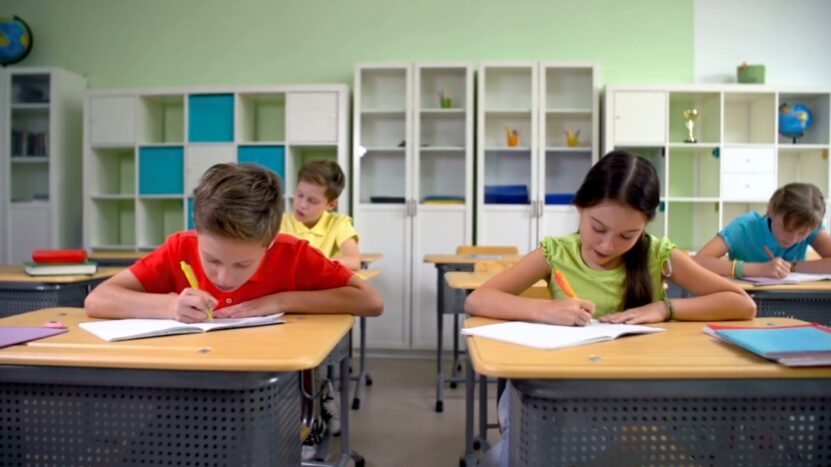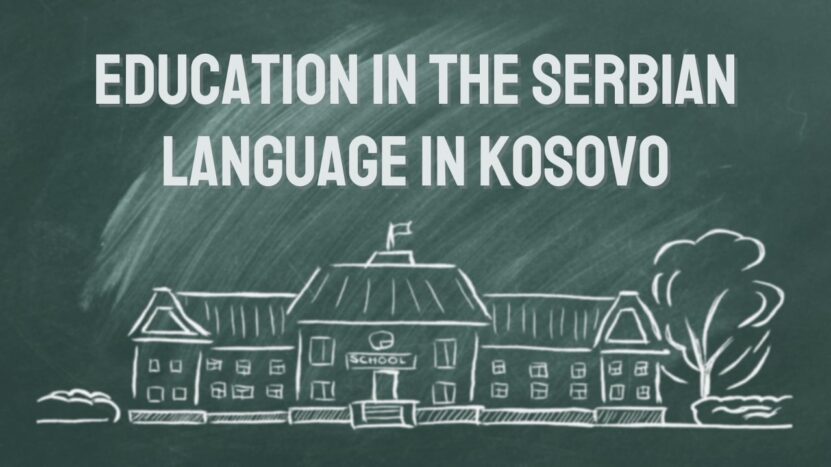Currently, Kosovo has two coexisting education systems. One is managed by the Government of Kosovo, specifically the Ministry of Education, Science and Technologies (MEST), offering education in Albanian, Turkish, and Bosnian.
The other is operated by the Republic of Serbia and its Ministry of Education, Science and Technological Development, providing education in Serbian.
Schools with Serbian-language instruction are situated in six Kosovo districts: Ferizaj/Uroševac, Gjilan/Gnjilane, Mitrovica/Mitrovicë, Pejë/Peć, Prishtinë/Priština, and Prizren, covering all districts except Gjakova/Đakovica. Approximately 17,456 pupils are enrolled in Serbian-language schools, including 69 primary and 34 secondary schools.
The parallel education systems in Kosovo can be traced back to the period before the 1998-99 conflict. Following the annulment of Kosovo’s autonomy by the Republic of Serbia in the 1980s and 1990s, the Albanian community withdrew from the official education system and organized an unrecognized parallel private education system.
These parallel education systems have continued to the present day, although with completely reversed roles. After the war, the establishment of the United Nations Mission in Kosovo (UNMIK) administration, and the declaration of Kosovo’s independence, the Albanian education network in Kosovo evolved into a formal education system.
In contrast, the Serbian-language system was relegated to the status of a parallel network, but unlike the Albanian private education system in the 1990s, which lacked external support, it is supported and recognized by the Serbian state.
While exploring education in the Serbian language in Kosovo, it’s essential to consider the broader context of minority rights, their history, and relevant laws and regulations to better understand the challenges and opportunities faced by minority communities.
The Current State of Serbian-Language Education in Kosovo

Presently, there are two coexisting education systems in Kosovo. The Government of Kosovo, specifically the Ministry of Education, Science, and Technologies (MEST), offers education in Albanian, Turkish, and Bosnian. The other system, operated by the Republic of Serbia and its Ministry of Education, Science, and Technological Development, provides education in Serbian.
Schools with Serbian-language instruction are situated in six Kosovo districts: Ferizaj/Uroševac, Gjilan/Gnjilane, Mitrovica/Mitrovicë, Pejë/Peć, Prishtinë/Priština, and Prizren, covering all districts except Gjakova/Đakovica. Approximately 17,456 pupils are enrolled in Serbian-language schools, including 69 primary and 34 secondary schools.
Curriculum and Teaching Methods in Serbian-Language Schools
The curriculum for Serbian-language schools in Kosovo is primarily based on the Serbian national curriculum, which emphasizes the development of linguistic and cultural identity, as well as a balanced education in various subjects such as mathematics, sciences, and social sciences.
Teaching methods in these schools often include traditional classroom instruction, project-based learning, and the use of digital technologies to enhance learning experiences.
Challenges and Opportunities in Serbian-Language Education
Serbian-language education in Kosovo faces several challenges, including limited resources, a lack of qualified teachers, and social and political tensions.
However, there are also opportunities for improvement and growth, such as increased collaboration between the two parallel education systems, the implementation of modern teaching methods, and the promotion of multiculturalism and tolerance in schools.
Building Bridges: Cooperation and Collaboration between Kosovo and Serbian Education Systems
In recent years, there have been efforts to encourage cooperation and collaboration between the parallel education systems in Kosovo, focusing on areas such as teacher training, curriculum development, and student exchange programs. These initiatives aim to foster mutual understanding and respect, as well as to promote the sharing of best practices and resources between the two systems.
The Future of Serbian-Language Education in Kosovo
The future of Serbian-language education in Kosovo is uncertain, as it depends on various factors such as political developments, resource allocation, and the willingness of stakeholders to cooperate and collaborate. However, there are several potential pathways for the advancement of Serbian-language education in the region:
Strengthening the Quality of Education
To ensure the continued success of Serbian-language education in Kosovo, it is essential to invest in teacher training and professional development programs, improve school infrastructure, and provide adequate resources for teaching and learning.
Furthermore, the integration of innovative teaching methods, such as digital learning tools, can enhance the quality of education in Serbian-language schools.
Promoting Multiculturalism and Inclusivity
Encouraging a spirit of multiculturalism and inclusivity in Serbian-language schools can foster a more positive learning environment for students from diverse backgrounds.
By promoting cultural exchange programs, language rights and learning opportunities, and extracurricular activities that encourage interaction among students from different communities, schools can help to build bridges between the parallel education systems in Kosovo.
Building Partnerships

Establishing partnerships between Serbian-language schools and other educational institutions, both within Kosovo and internationally, can create opportunities for collaboration and resource-sharing.
These partnerships can lead to joint projects, teacher exchanges, and shared professional development opportunities that benefit both the Serbian-language schools and their partner institutions.
Engaging Stakeholders
Involving key stakeholders, such as parents, local communities, and policymakers, in the decision-making process and development of Serbian-language education can create a more supportive and sustainable environment for these schools.
Open dialogue and cooperation among stakeholders can lead to a better understanding of the challenges faced by Serbian-language schools and the development of effective strategies to address these challenges.
Advocating for Policy Changes
Advocating for policy changes at the national and international levels can help to create a more favorable environment for Serbian-language education in Kosovo. These policy changes may include increased funding, the recognition of Serbian-language qualifications, and the development of more inclusive and equitable education policies.
As you examine the education landscape for Serbian language speakers in Kosovo, you might also be interested in learning about the diploma verification process at the University of Mitrovica North, a prominent institution in the region.
The Role of Non-Governmental Organizations (NGOs) and International Agencies

Non-governmental organizations (NGOs) and international agencies play a significant role in supporting Serbian-language education in Kosovo. Their involvement includes providing financial resources, capacity building, and technical assistance to help improve the quality of education and promote social cohesion in the region.
By collaborating with local stakeholders, these organizations can address the unique challenges faced by Serbian-language schools and contribute to positive change in the education sector.
- Financial Support: NGOs and international agencies often provide funding for Serbian-language schools to improve infrastructure, purchase teaching materials, and support extracurricular programs. This financial support helps to address resource limitations and ensures that schools can offer a high-quality education to their students.
- Capacity Building and Professional Development: These organizations may also offer training programs and workshops for teachers, administrators, and other education professionals in Serbian-language schools. These capacity-building initiatives focus on enhancing teaching skills, promoting inclusive education practices, and fostering leadership development.
- Technical Assistance: NGOs and international agencies can provide technical assistance to Serbian-language schools by sharing best practices, developing curriculum materials, and supporting the implementation of innovative teaching methods. This assistance helps schools to adopt modern approaches to education and improve learning outcomes for their students.
- Advocacy and Awareness Raising: By advocating for policy changes and raising awareness about the importance of Serbian-language education, NGOs and international agencies can help to create a more supportive environment for these schools. They may work to influence national and international education policies, promote the recognition of Serbian-language qualifications, and encourage dialogue between different education stakeholders.
- Promoting Social Cohesion and Reconciliation: Many NGOs and international agencies have a specific focus on fostering social cohesion and reconciliation through education. They may support programs that encourage cultural exchange, language learning, and interaction between students from different ethnic backgrounds, thereby promoting tolerance and understanding among diverse communities.
Examples of NGOs and international agencies involved in Serbian-language education in Kosovo include the United Nations Children’s Fund (UNICEF), the European Union (EU), the Organization for Security and Co-operation in Europe (OSCE), and various national and international NGOs.
These organizations play a vital role in supporting the development of Serbian-language education and addressing the unique challenges faced by these schools in Kosovo.
FAQs
What is the history of Serbian-language education in Kosovo?
Serbian-language education in Kosovo has its roots in the parallel education systems that emerged before the 1998-99 conflict. Following the annulment of Kosovo’s autonomy by the Republic of Serbia in the 1980s and 1990s, the Albanian community withdrew from the official education system and organized an unrecognized parallel private education system.
After the war, the establishment of the United Nations Mission in Kosovo (UNMIK) administration, and the declaration of Kosovo’s independence, the Albanian education network in Kosovo evolved into a formal education system, while the Serbian-language system was relegated to the status of a parallel network, supported and recognized by the Serbian state.
How many Serbian-language schools are there in Kosovo, and where are they located?
There are approximately 69 primary and 34 secondary Serbian-language schools in Kosovo, with a total enrollment of around 17,456 pupils. These schools are located in six districts of Kosovo: Ferizaj/Uroševac, Gjilan/Gnjilane, Mitrovica/Mitrovicë, Pejë/Peć, Prishtinë/Priština, and Prizren, covering all districts except Gjakova/Đakovica.
What is the curriculum for Serbian-language schools in Kosovo?
The curriculum for Serbian-language schools in Kosovo is primarily based on the Serbian national curriculum, which emphasizes the development of linguistic and cultural identity, as well as a balanced education in various subjects such as mathematics, sciences, and social sciences.
What are the main challenges facing Serbian-language education in Kosovo?
Serbian-language education in Kosovo faces several challenges, including limited resources, a lack of qualified teachers, and social and political tensions. These challenges are exacerbated by the parallel nature of the education systems, which can hinder collaboration and resource-sharing between the Serbian-language and Albanian-language schools.
Watch this video for additional fun facts you might be interested about Serbian language and Serbia in general:
What role do NGOs and international agencies play?
NGOs and international agencies play a significant role in supporting Serbian-language education in Kosovo by providing financial resources, capacity building, technical assistance, advocacy, and promoting social cohesion and reconciliation.
These organizations work in collaboration with local stakeholders to address the unique challenges faced by Serbian-language schools and contribute to positive change in the education sector.
How can Serbian-language education in Kosovo be improved and sustained in the future?
There are several potential pathways for the advancement of Serbian-language education in Kosovo, such as strengthening the quality of education, promoting multiculturalism and inclusivity, building partnerships, engaging stakeholders, and advocating for policy changes.
By investing in these areas, Serbian-language education in Kosovo can continue to thrive and contribute to the overall development of the region’s education system.
What initiatives are currently in place to encourage cooperation and collaboration between the parallel education systems?
In recent years, efforts have been made to encourage cooperation and collaboration between the parallel education systems in Kosovo. These initiatives focus on areas such as teacher training, curriculum development, and student exchange programs.
They aim to foster mutual understanding and respect, as well as to promote the sharing of best practices and resources between the two systems.

